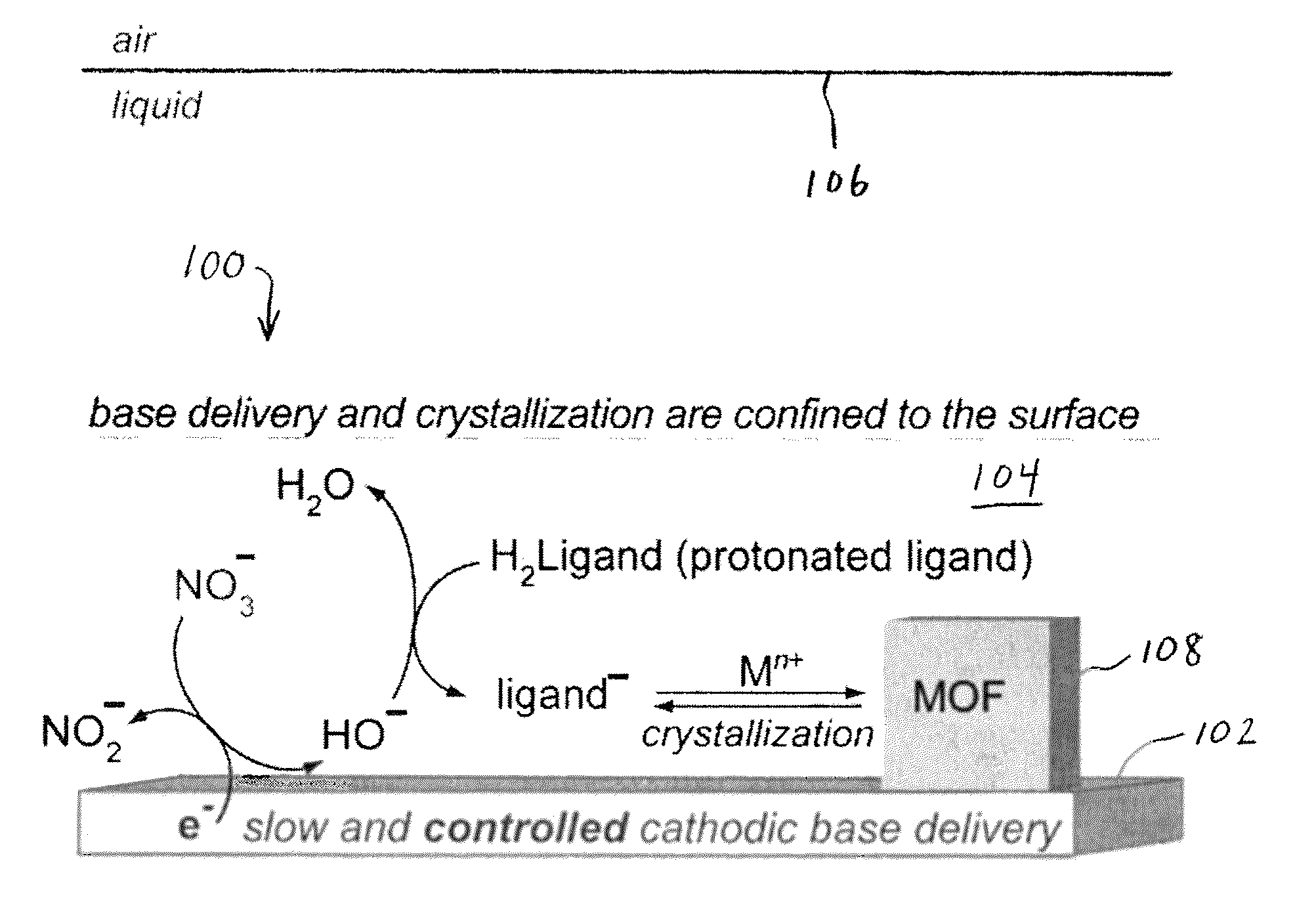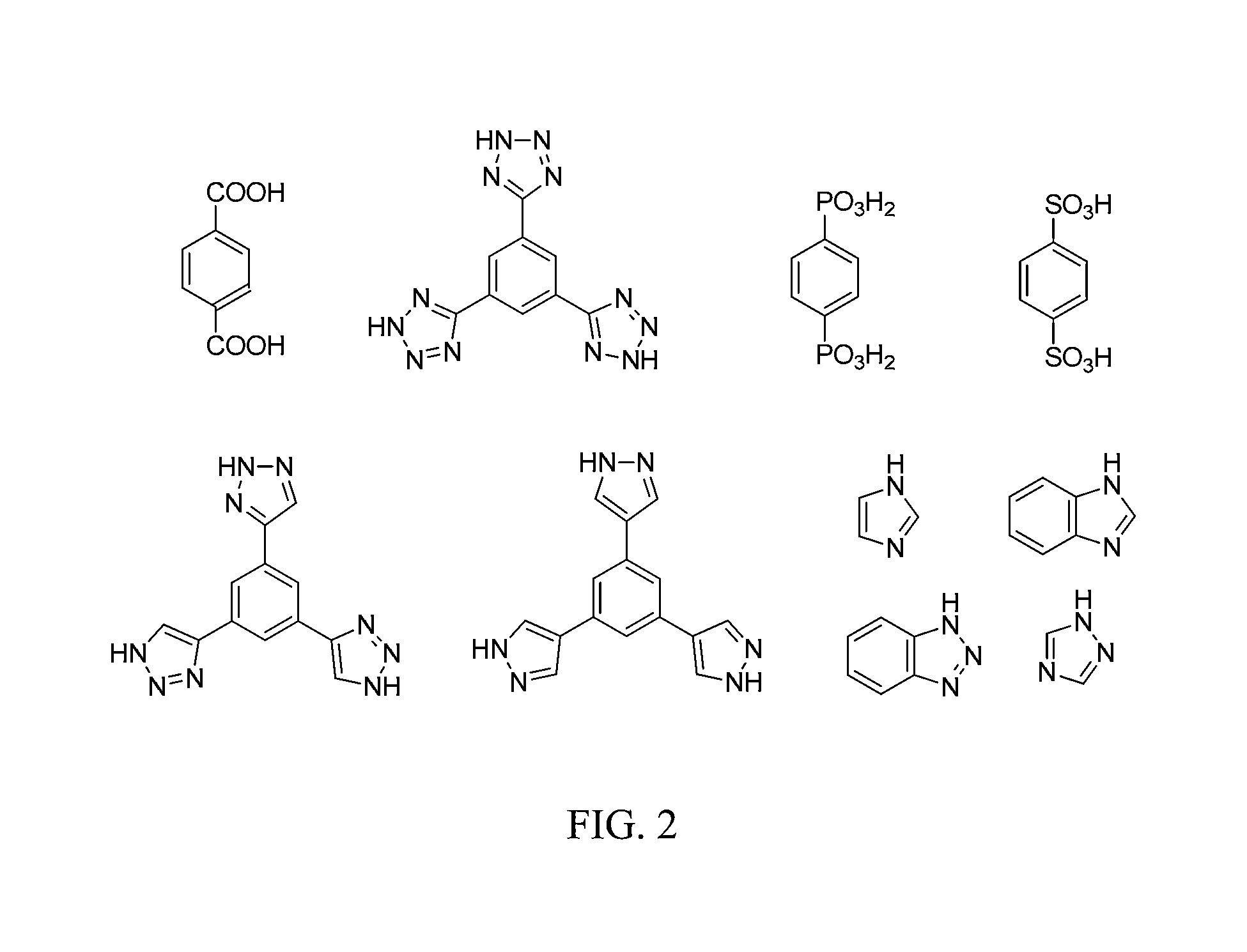Methods for electrochemically induced cathodic deposition of crystalline metal-organic frameworks
a metal-organic framework and electrochemical induced technology, applied in metal layered products, printing, electrical equipment, etc., can solve the problems of inefficiency of current methods, incompatible with many proposed applications, and difficult to grow mofs on surfaces to date, and achieve fast reaction times.
- Summary
- Abstract
- Description
- Claims
- Application Information
AI Technical Summary
Benefits of technology
Problems solved by technology
Method used
Image
Examples
experimental examples
Example 1
[0069]A working electrolyte solution was produced by dissolving tetrabutylammonium hexafluorophosphate (TBAPF6, 1.94 g, 5.01 mmol, Sigma-Aldrich, 99.0% purity) in 50 mL of N,N-dimethylformamide (DMF) in a 100 mL Airfree® storage vessel. DMF was previously dried and deaerated through a solvent purification column. A quantity of 0.5 mL of water (Ricca, ASTM Type I, 18 MΩ cm resistivity) was subsequently added to the DMF solution to provide a 1% water content. Water is necessary for cathodic generation of hydroxide (see Table 1). The working electrolyte solution was deaerated once again using three consecutive freeze-pump-thaw cycles. The vessel was then brought into a nitrogen-filled glovebox. All further electrochemical experiments were performed inside the glovebox to avoid O2 contamination of the solution. O2 can get reduced itself, thus interfering with cathodic processes due to reduction. However, in an industrial setting, this step may not be necessary, because the reac...
example 2
[0074]Cathodic electrodeposition was used to synthesize Zn4O(NH2-BDC)3 (IRMOF-3). The procedure began by dissolving 45 mg of NH2-BDC (2-amino-1,4-benzenedicarboxylic acid) and 345 mg of Zn(NO3)2*4.5H2O in a 10 mL solution of 0.1M TBAPF6 (tetrabutylammoniumhexafluorophosphate) in DMF (N,N-dimethylformamide, dried and deaerated with argon) and 1% v / v water. The solution was shaken vigorously until dissolution and transferred to a two compartment glass H-cell equipped with a sintered glass filter. An FTO-covered glass working electrode was used, with a 1 cm2 platinum mesh counter electrode, and a Ag / Ag (cryptand) reference electrode. Approximately 1×1 cm2 of active electrode was exposed to solution. The cell was capped and purged with N2 for 30 minutes, before electrolyzing at −1.5 V for 15 minutes under a N2 blanket. Yellow-brown crystallites formed on the FTO surface along with metallic zinc. Referring to the X-ray diffraction results and predictions in FIG. 6, IRMOF-3 is isostructur...
example 3
[0075]Cathodic electrodeposition was used to synthesize [Et3NH]2[Zn3(BDC)4]*DMF. The process began by stirring 84 mg of H2BDC, 500 mg of Zn(NO3)2*8H2O, and 500 mg of Et3NHCl (triethylammonium chloride) in a 10 mL solution of 0.1 M TBAPF6 in dry and deaerated DMF solution. The stirring was performed under a nitrogen purge for 30 minutes inside a custom H-cell, containing a 1 cm2 Pt mesh working electrode, a 4 cm2 Pt mesh counter electrode, and a Ag / Ag (cryptand) reference electrode. A constant potential of −1.5 V was applied for 4 hrs. A gray solid layer was observed to form on the electrode after deposition. A small amount of Zn(BDC)*DMF was found to co-precipitate. X-ray diffraction results and predictions for the material produced during the experiment are presented in FIG. 7.
PUM
| Property | Measurement | Unit |
|---|---|---|
| diameter | aaaaa | aaaaa |
| current density | aaaaa | aaaaa |
| thickness | aaaaa | aaaaa |
Abstract
Description
Claims
Application Information
 Login to View More
Login to View More - R&D
- Intellectual Property
- Life Sciences
- Materials
- Tech Scout
- Unparalleled Data Quality
- Higher Quality Content
- 60% Fewer Hallucinations
Browse by: Latest US Patents, China's latest patents, Technical Efficacy Thesaurus, Application Domain, Technology Topic, Popular Technical Reports.
© 2025 PatSnap. All rights reserved.Legal|Privacy policy|Modern Slavery Act Transparency Statement|Sitemap|About US| Contact US: help@patsnap.com



